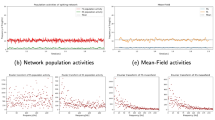Summary
The activity rhythms of 5 flying squirrels,Glaucomys volans, and 7 chipmunks,Tamias striatus, were examined under controlled conditions in the laboratory. Free-running, circadian rhythms were demonstrated using a total of 25 LL or DD experiments. With 46 LD schedules the limits of entrainment in a 24-hour day were determined, and the phase angle difference for each schedule measured.Glaucomys was able to synchronize to schedules ranging from 1 second of light per 24-hour day to at least 18 hours light per day with little or no change in the phase angle.Tamias showed an oscillatory type of entrainment when the photoperiod was less than 3 hours per 24-hour day or greater than 23 hours, but in the intervening region was capable of stable entrainment. A tendency was evident for the phase angle difference to become less positive as the LD ratio increased. InGlaucomys single, isolated light pulses of either one second or 24 hours duration were able to bring about relatively large shifts in the phase of the activity rhythm.
Similar content being viewed by others
References
Aschoff, J.: Exogenous and endogenous components in circadian rhythms. Cold Spr. Harb. Symp. quant. Biol.25, 11–28 (1960).
Aschoff, J.: Comparative physiology: diurnal rhythms. Ann. Rev. Physiol.25, 581–600 (1963).
Aschoff, J.: The phase angle difference in circadian periodicity. In: Circadian clocks (J. Aschoff, ed.), p. 262–276. Amsterdam: North-Holland Publ. Co. 1965a.
Aschoff, J.: Response curves in circadian periodicity. In: Circadian clocks (J. Aschoff, ed.), p. 95–111. Amsterdam: North-Holland Publ. Co. 1965b.
Aschoff, J. (ed.): Circadian clocks. Amsterdam: North-Holland Publ. Co. 1965c.
Aschoff, J.: Phasenlage der Tagesperiodik in Abhängigkeit von Jahreszeit und Breitengrad. Oecologia3, 125–165 (1969).
Aschoff, J., Gwinner, E., Kureck, A., Müller, K.: Diel rhythms of chaffinchesFringilla coelebs L., tree shrewsTupaia glis L., and hamstersMesocricetus auratus L. as a function of season at the Arctic Circle. Oikos13, 91–100 (1970).
Aschoff, J., Klotter, K., Wever, R.: Circadian vocabulary. In: Circadian clocks (J. Aschoff, ed.), p. x-xix. Amsterdam: North-Holland Publ. Co. 1965.
Aschoff, J., Wever, R.: Beginn und Ende der täglichen Aktivität freilebender Vögel. J. Ornithol.103, 2–27 (1962a).
Aschoff, J., Wever, R.: Aktivitätsmenge und α-ϱ-Verhältnis als Meßgrößen der Tagesperiodik. Z. vergl. Physiol.46, 88–101 (1962b).
Aschoff, J., Wever, R.: Über Phasenbeziehungen zwischen biologischer Tagesperiodik und Zeitgeberperiodik. Z. vergl. Physiol.46, 115–128 (1962c).
Aschoff, J., Wever, R.: Circadian rhythms of finches in light-dark cycles with interposed twilights. Comp. Biochem. Physiol.16, 507–514 (1965).
Chauvnick, A. (ed.): Biological clocks. Cold Spr. Harb. Symp. quant. Biol.25 (1960).
DeCoursey, P.: Phase control of activity in a rodent. Cold Spr. Harb. Symp. quant. Biol.25, 49–56 (1960).
DeCoursey, P.: Effect of light on the circadian activity rhythm of the flying squirrel,Glaucomys volans. Z. vergl. Physiol.44, 331–354 (1961).
DeCoursey, P.: Function of a light response system in hamsters. J. cell. comp. Physiol.63, 189–196 (1964).
DeCoursey, P.: Free-running rhythms and entrainment in three species of day- active rodents. In preparation, 1972a.
DeCoursey, P.: Effect of day length on synchronization phase inGlaucomys. In preparation, 1972b.
Enright, J. T.: Synchronization and ranges of entrainment. In: Circadian clocks (J. Aschoff, ed.), p. 112–124. Amsterdam: North-Holland Publ. Co. 1965.
Enright, J. T.: Influences of seasonal factors on the activity onset of house finches. Ecol.47, 662–666 (1966).
Erkinaro, E.: Wirkung von Tageslänge und Dämmerung auf die Phasenlage der 24-h Periodik der WaldmausApodemus flavicollis Melch. Im Naturtag. Oikos13, 101–107 (1970).
Erkert, S.: Der Einfluß des Lichtes auf die Aktivität von Flughunden (Megachiroptera). Z. vergl. Physiol.67, 243–272 (1970).
Eskin, A.: The sparrow clock: behavior of the free-running rhythm and entrainment analysis. Ph. D. Thesis, U. Texas, Austin (1969).
Graefe, G.: Die Aktivitätsperiodik des Flughörnchens,Glaucomys volans L. und des Backenhörnchens,Tamias striatus L. Z. Tierpsychol.18, 84–90 (1961).
Hoffmann, K.: Zur Beziehung zwischen Phasenlage und Spontanfrequenz bei der endogenen Tagesperiodik. Z. Naturforsch.18b, 154–157 (1963).
Justice, K.: Nocturnalism in three species of desert rodent. Ph. D. Thesis, U. Arizona, Tucson (1960).
Kramm, K.: Circadian activity in the antelope squirrel,Ammosperomophilus leucurus. Ph. D. Thesis, U. California, Irvine (1971).
Menaker, M. (ed.): Biochronometry. Washington, D. C.: Nat. Acad. Sci. 1971.
Minis, D.: Parallel peculiarities in the entrainment of a circadian rhythm and photoperiodic induction in the pink boll worm (Pectinophora gossypiella). In: Circadian clocks (J. Aschoff, ed.), p. 333–343. Amsterdam: North-Holland Publ. Co. 1965.
Pittendrigh, C. S.: Circadian rhythms and the circadian organization of living systems. Cold Spr. Harb. Symp. quant. Biol.25, 159–184 (1960).
Pittendrigh, C. S.: On the mechanism of the entrainment of a circadian rhythm by light cycles. In: Circadian clocks (J. Aschoff, ed.), p. 277–297. Amsterdam: North-Holland Publ. Co. 1965.
Rawson, K. D.: Homing behavior and endogenous activity rhythms. Ph. D. Thesis, Harvard University (1956).
Stewart, M. C., Reeder, W. B.: Temperature and light synchronization experiments with circadian activity rhythms in two color forms of the rock pocket mouse. Physiol. Zool.41, 149–156 (1968).
Swade, R. H.: Circadian rhythms in the Arctic. Ph. D. Thesis, Princeton University (1964).
Swade, R. H., Pittendrigh, C. S.: Circadian locomotor rhythms of rodents in the Arctic. Amer. Naturalist101, 431–466 (1967).
Wever, R.: Zum Einfluß der Dämmerung auf die circadiane Periodik. Z. vergl. Physiol.55, 255–277 (1967).
Author information
Authors and Affiliations
Additional information
Dedicated to Professor Jürgen Aschoff on the occasion of his 60th birthday.
I wish to acknowledge the hospitality and assistance of the Zoology Department, University of Wisconsin, Madison, the Max-Planck Institute, Erling-Andechs, Germany, and the Belle W. Baruch Coastal Research Institute, University of South Carolina, Columbia. Special thanks are due Dr. John Emlen and Dr. William Reeder of Madison, Prof. J. Aschoff of Erling-Andechs, Dr. John Vernberg and Dr. Winona Vernberg of Columbia, and my husband, Dr. George DeCoursey, for their untiring encouragement and help with these experiments.
Rights and permissions
About this article
Cite this article
DeCoursey, P.J. LD ratios and the entrainment of circadian activity in a nocturnal and a diurnal rodent. J. Comp. Physiol. 78, 221–235 (1972). https://doi.org/10.1007/BF00697656
Received:
Issue Date:
DOI: https://doi.org/10.1007/BF00697656




